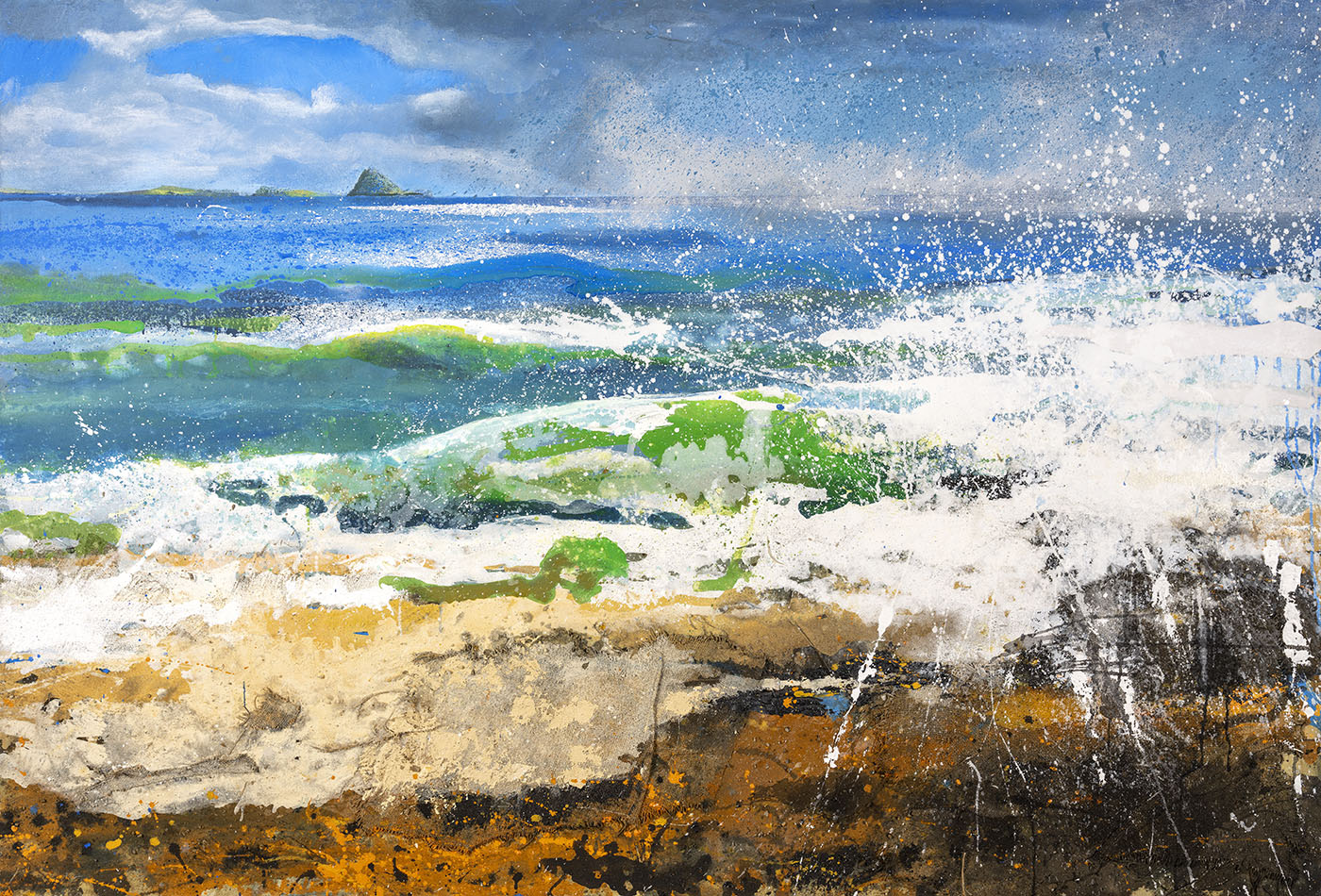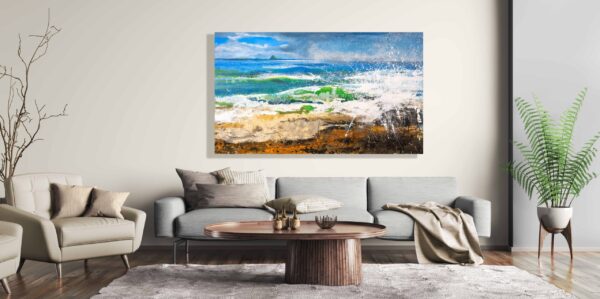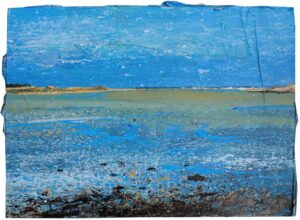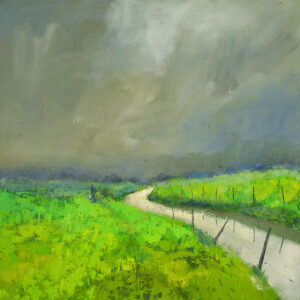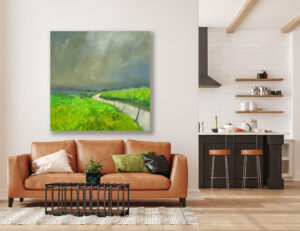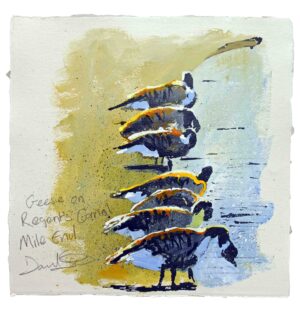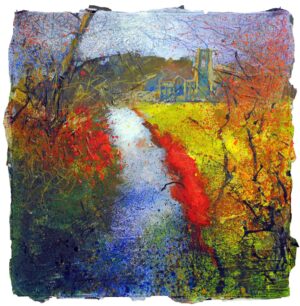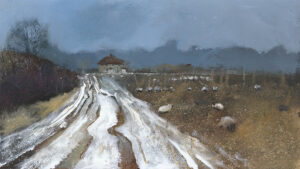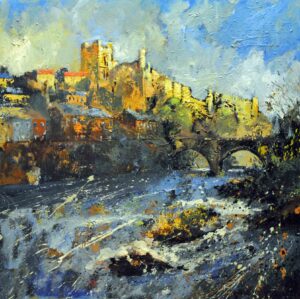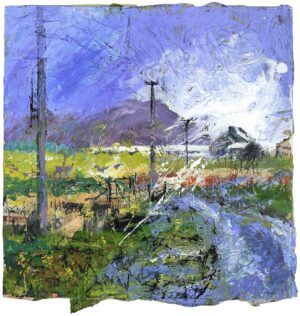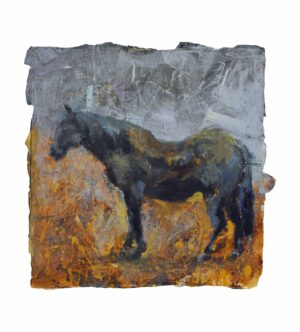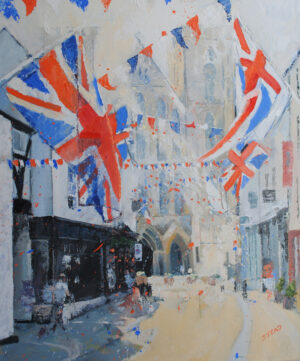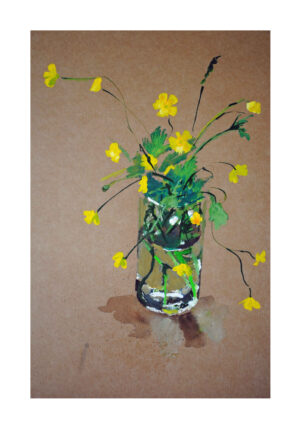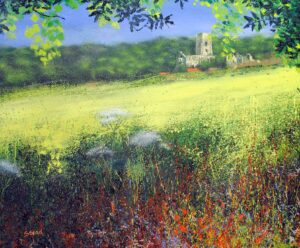Lindisfarne
Original Sold
Prints available
- Title, Lindisfarne
- Medium: Acrylic & collage
- Substrate: 12oz cotton canvas
- Print Size: 142cm x 97cm x 4cm
- Style: Contemporary
- Frame: No
David Stead’s painting *Lindisfarne* is a vivid testament to his mastery of mixed media and his deep connection to the Northumberland coast. Created in his Norton Conyers studio from studies made en plein air, this artwork captures the dynamic interplay between land, sea, and sky, reflecting Stead’s commitment to portraying the raw beauty of nature.
Composition
The composition of *Lindisfarne* is both dynamic and balanced. The foreground is dominated by the rugged black igneous rocks of the Whin Sill, their dark tones anchoring the viewer’s gaze. These rocks, shaped by millennia of geological activity, provide a tactile sense of permanence against the ever-changing sea. The middle ground features the churning waves of the North Sea, rendered with fluid brushstrokes that convey movement and energy. Holy Island itself sits near the horizon, its distant presence enhancing the sense of isolation and tranquility. The horizon line is slightly off-centre, creating a sense of depth and drawing the eye across the canvas. This arrangement invites the viewer to journey from the solid earth to the expansive sky, mirroring the physical experience of standing on the shores of Lindisfarne.
Mood
The mood of the painting is one of awe and contemplation. The tumultuous waves crashing against the shore evoke a sense of nature’s power and unpredictability, while the distant island suggests solitude and introspection. The interplay between the turbulent sea and the calm horizon reflects the duality of human experience—chaos and peace, struggle and serenity. Stead’s use of mixed media techniques, such as layering sand and hessian with acrylic paint, adds texture and depth, enhancing the emotional resonance of the scene. The tactile quality of the surface invites viewers to not only see but also feel the landscape, immersing them in the atmosphere of Lindisfarne.
Colours
The colour palette of *Lindisfarne* is both earthy and vibrant, capturing the essence of the Northumberland coast. The foreground is dominated by rich ochres and browns, reflecting the sandy shores and rocky outcrops. These warm tones contrast with the cool blues and greens of the sea, which range from deep navy to frothy white as the waves break upon the shore. The sky above transitions from stormy greys to patches of blue, suggesting an ever-changing atmosphere. Stead’s use of colour is not merely representational but expressive, conveying the mood of the landscape and the artist’s personal response to it. The layering of colours, achieved through techniques like rubbing, scratching, and pouring, adds complexity and movement to the painting, mirroring the dynamic nature of the coastal environment.
In conclusion, David Stead’s *Lindisfarne* is a compelling work that captures the essence of the Northumberland coast through its thoughtful composition, evocative mood, and expressive use of colour. By combining traditional techniques with innovative approaches, Stead creates a landscape that is both familiar and otherworldly, inviting viewers to experience the beauty and drama of Lindisfarne.
Lindisfarne or Holy Island on the Northumberland coast in Northern England is a spectacular ‘island’ connected to the mainland by a causeway. The causeway is covered by the sea at high tide and woe-betide the unwary traveller who fails to check tide times before venturing across. The recorded history of Holy Island dates as far back as the 6th century. In 635 a monastery was founded at Lindisfarne by St Aidan as a centre of early Celtic Christianity. He was succeeded by St Cuthbert in whose lifetime the Lindisfarne gospels were written and upon whose death his body refused to decay, thereby attracting pilgrims from all over Europe and bringing wealth to the monastery (people certainly knew how to have a good time in those days!).
Arguably Britain’s greatest artist JMW Turner drew and painted the island on his 1797 tour of the north of England. Turner’s friend and almost exact contemporary, Thomas Girtin, who sadly died at the early age of just 27, had also visited Lindisfarne the previous year and exhibited two watercolours of the subject at the Royal Academy in 1797 just before Turner set off. It’s likely the two friends discussed the subject prior to Turner’s trip as they recorded exactly the same subjects.
An original mixed media painting by David Stead, now available as a beautiful limited edition print on deep profile, archival quality canvas. The print is limited to an edition of only 150 and comes with a certificate of authentication

